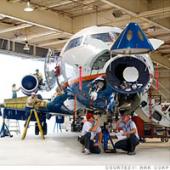Aircraft Mechanic

Alternate Job Title: Airframe, Powerplant, and Aviation Maintenance Technician
Job Description: Aircraft and avionics equipment mechanics and service technicians perform scheduled maintenance, make repairs, and complete inspections required by the Federal Aviation Administration (FAA) in order to keep aircraft in peak operating condition. Some mechanics work on one or many different types of aircraft, such as propeller-driven airplanes, jets, and helicopters. Others specialize in one section of a particular type of aircraft, such as hydraulics, the engine, or electrical system.
Airframe mechanics are authorized to work on any part of the aircraft except the instruments, powerplants, and propellers. Powerplant mechanics are authorized to work on engines and do limited work on propellers. Combination airframe-and-powerplant mechanics—called A & P mechanics—work on all parts of the plane, except instruments. The majority of mechanics working on civilian aircraft today are A & P mechanics. In small, independent repair shops, mechanics usually inspect and repair many different types of aircraft.
Working Conditions: Mechanics usually work in hangars or in other indoor areas, but they can also work outdoors—sometimes in unpleasant weather—when hangars are full or when repairs must be made quickly. Mechanics often work under pressure to meet time deadlines in order to maintain flight schedules or keep from inconveniencing customers, as is the case in general aviation. At the same time, mechanics have a tremendous responsibility to maintain safety standards, and this can cause the job to be stressful.
Aviation mechanics must frequently lift or pull objects weighing as much as 70 pounds. They often stand, lie, or kneel in awkward positions and occasionally must work in precarious positions on ladders or scaffolds. Noise and vibration are common when engines are being tested, so ear protection is necessary. Aircraft mechanics usually work 40 hours a week on eight-hour shifts around the clock. Overtime work is frequent.
Education and Training Requirements: The majority of mechanics who work on civilian aircraft are certificated by the FAA as “powerplant mechanic,” “airframe mechanic,”or “avionics repair specialist.” Mechanics who also have an inspector’s authorization can certify work completed by other mechanics and perform required inspections. Uncertificated mechanics are supervised by those with certificates.
Although a few people become mechanics with on-the-job training, most learn their job in one of about 200 trade schools certified by the FAA. About one-third of these schools award two- and four-year degrees in avionics, aviation technology, or aviation maintenance management.
Salary Range:
Median Hourly Wage: $21.00
Middle 50 percent: $17-$25.00
Highest 10 percent: Greater than $29.00
Job Outlook: Opportunities for avionics and aircraft equipment mechanics and service technician jobs should be excellent for persons who have completed aircraft mechanic training programs. Employment of aircraft mechanics is expected to increase about as fast as the average for all occupations through the year 2012, and large numbers of additional job openings should arise from the need to replace experienced mechanics who retire.
Are you interested in becoming an aircraft mechanic? Please check out our list of featured schools below that offer aviation maintenance programs. Request free information and jump start your career today.

- Facebook Like
- Google Plus One
- 10640 reads
